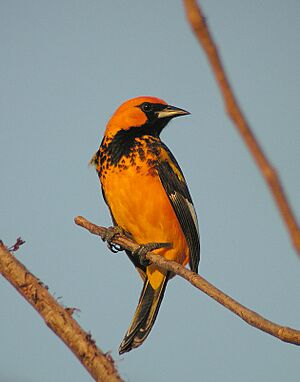Spot-breasted oriole facts for kids
Quick facts for kids Spot-breasted oriole |
|
|---|---|
 |
|
| Icterus pectoralis espinachi, Costa Rica | |
| Conservation status | |
| Scientific classification | |
| Genus: |
Icterus
|
| Species: |
pectoralis
|
The spot-breasted oriole (its scientific name is Icterus pectoralis) is a colorful bird. It belongs to the Icteridae family, which includes other orioles and blackbirds.
What Does It Look Like?
The spot-breasted oriole is a medium-sized songbird. It is mostly bright orange. This bird has a black "bib" on its chest and black spots on the sides of its breast.
Both male and female orioles look quite similar. However, females and young birds have olive-green backs and tails. Their wings are a bit darker. They also have less black on their face, throat, or chest.
Adult orioles are about 21 to 24 centimeters (8 to 9 inches) long. Males usually weigh around 50 grams (1.8 ounces). Females are a little lighter, weighing about 45 grams (1.6 ounces). Their wings can be 8.8 to 11.4 centimeters long. Their tails are about 8.5 to 11.2 centimeters long. The top part of their beak (called the culmen) is 1.9 to 2.4 centimeters long. Their lower leg bone (the tarsus) is 2.6 to 3 centimeters long.
Where Do They Live?
The spot-breasted oriole is originally from Central America. You can find it in countries like Costa Rica, El Salvador, Guatemala, Honduras, Mexico, and Nicaragua.
These birds prefer certain types of habitats. They live in dry tropical forests. They also live in moist lowland forests in warm areas. Sometimes, they can be found in areas where forests have been cut down.
The spot-breasted oriole usually lives on the Pacific side of Central America. However, some of these birds were brought to the Atlantic coast of southern Florida. They have started to breed there. Now, there are enough of them that birdwatchers count them as part of the local bird population.
Images for kids




